
Disclaimer-- The following could contain errors and no expertise is claimed.
The Roland KC-500 is an earlier version of the still-current KC-550 keyboard amp. Both models are similar except the newer KC-550 has a slightly higher power rating. There are surely assorted other minor differences.
My KC-500 is about 20 years old and has not been heavily used. Hasn't much been dropped out of trucks doing road work. I mainly got the amp to be the bass module matched with a Motion Sound Rotary Horn module in home studio. But the KC-500 has done the occasional spot gig.
Most of my past music work was long-term house gigs. I only did occasional sub gigs after about 1995, mostly busy full-time music app programming until recent retirement. After I quit full-time gigging for full-time programming, once or twice a month I would sub for other keyboardists, playing their equipment on their long-term house gigs. I didn't have to move gear for most of the subbing work. I tended to avoid spot gigs because it was too much hassle loading and wiring equipment just to play one night. Setup needs to be as easy/fast possible for spot gigs to be tolerable.
Equipment doesn't need to be small and light for house gigs-- One of my favorite house gig keyboard stage speakers were a pair of old ported EV threeway speakers loaded with 18 inch woofers, thiele cone midrange drivers and good old T-35 tweeters. Those old EV's are very satisfying stage keyboard speakers. The speakers are not incredibly huge but they are rather damn heavy to tote to casual spot gigs. More appropriate van freight than jeep freight.
Nowadays putting together “as small and
light possible” spot gig rig, KC-500 advantages include--
_
Paid-for so I don't have to buy something new.
_ Relatively
compact and not incredibly heavy.
_ Fits my Jeep Wrangler and has
removable caster wheels.
_ Built-in mixer, stereo line out and
stereo link options.
_ Not the worst-sounding keyboard amp ever
made.
I can think of several keyboard amps worse-sounding than the KC-500, but wished it sounds better. On some keyboard patches it sounded good but with borderline quality on such as Acoustic Piano patches. Audible deficiencies can be noticed by playing popular recorded music on the KC-500. The first few minutes tend to sound “not so bad” playing records but it doesn't take long for the mids to become fatiguing and plastic-sounding. Lows and highs are not so bad but mids are not “clear enough” to my ear. The longer you listen, the worse it sounds. Sounds better on keyboards than full mixes but regardless it could benefit from better sound.
What is the Problem?
A (possibly wrong) explanation-- The 15 inch woofer is driven full-range, in parallel with a “pretty good quality” fostex bullet tweeter with a simple first-order highpass filter. The highpass filter consists of a 15 Ohm resistor in series with a 1.5 uF capacitor. The -3 dB frequency of this simple crossover would be the 15 ohm resistor + 8 (nominal) ohm tweeter, 23 ohms in series with the 1.5 uF cap. Fc = 1 / (2 * pi * 1.5e-6 Farads * 23 Ohms) = 4613 Hz.
Additionally, well into the passband (well above 4.6 kHz) the tweeter output would be attenuated by the 15 Ohm resistor-- 20 * log10(8 Ohms / 23 Ohms) = -9 dB passband attenuation. Of course the attenuation also applies to frequencies near or below the crossover frequency. Which is “about right” because good pro-audio tweeters and horns are typically more efficient than high-efficiency pro cone speakers. This analysis seems in the ballpark with Roland's published KC-500 schematic, which lists the typical clean woofer drive at 32 volts RMS and the clean tweeter drive at 3 volts RMS.
I apparently never played the KC-500 loud enough to blow the tweeter but there are frequent internet user complaints about blown KC-500 tweeters. Overloaded amp distortion is especially likely to blow a tweeter and a first-order crossover is not really steep enough to properly protect a tweeter. Tweeters or horns blow easy if hit by excessive low-frequencies.
Regarding the woofer-- If you drive a cone speaker with too-high frequencies, the audio has narrow audio dispersion. We also get “speaker breakup” as cone resonance and flexure adds mechanical distortion to excessively high frequencies. Speaker breakup most always happens even with very high quality speakers, when speakers are driven with excessively high frequencies. To avoid break-up distortion, IMO most 15 inch speakers should not be subjected to frequencies higher than about 800 Hz.
The KC-500 tweeter crossover is about the correct frequency but the filter slope is too gradual. At higher sound levels we might expect some audibly-noticeable tweeter distortion perhaps as low as 1200 Hz or lower. Compounding the problem, the 15 inch woofer will probably be narrow-dispersion and somewhat distorted above about 800 Hz. Such a system might sound better than something even worse but this is far from ideal if we want clean mids. Keyboards need clean mids.
The KC-500 OEM woofer--

The KC-500 OEM Fostex bullet tweeter--

How to make it better?
I wanted to improve the sound “as good feasible” on as low possible budget. Last year I made some homemade studio monitors out of Seismic Audio 12 inch coax speakers. These are not the fanciest coax speakers ever made but are really good for the money so far as I can tell. I wanted to crossover those studio monitors as low possible and substituted the included SA titanium compression drivers with Dayton Audio Polyimide Diaphragm drivers. The SA titanium drivers probably work fine but the SA published specs look “possibly not friendly” to low crossover frequencies. I wanted as low crossover frequency I could get away with. At the low power required for the homemade studio monitors, 1000 Hz crossover frequency works fine with a 24 dB per octave electronic crossover but I suspect the drivers would distort or blow out driven that low at louder stage volumes.
Were the KC-500 speaker cab bigger, I would have kept the OEM woofer + tweeter and added an efficient cone midrange speaker with a threeway crossover. Unfortunately, the advantage of being a small cabinet prevents adding a midrange speaker. The KC-500 cabinet just isn't big enough to add a proper midrange cone speaker or a big mid-horn.
So a 15 inch coax speaker seemed the best alternative to cheaply improve the KC-500. I decided to use the same Dayton Audio Polyimide driver which worked fine with the 12 inch studio monitors. The SA 15 inch coax horn is bigger than the SA 12 inch coax horn. Therefore the SA 15 inch coax horn ought to handle lower crossover frequencies than the SA 12 inch coax horns. But the keyboard amp will be louder than the studio monitors. Decided to try a 1200 Hz 24 dB / oct Linkwitz-Riley passive crossover. Hopefully that is high enough to avoid mid-driver distortion or blowout. Higher crossover frequency would be safer but I want to crossover “as low as feasible” for “clean as feasible” mids. Given a 15 inch woofer, I would prefer 800 Hz if not 500 Hz or lower, could I get away with it. But a coax horn is not big enough and the cabinet is not big enough to hold a big horn.
Reading a bit of classical horn theory-- Supposedly a “maximally efficient” conical horn would have a length equal to the wavelength of the low cutoff frequency. Also the front opening would have a circumference equal to the wavelength of the low cutoff frequency. Given a 1200 Hz cutoff frequency and speed of sound 1125 feet per second-- According to this horn theory rule-of-thumb, horn length ought to be 1125 ft / 1200 Hz = about 0.9375 feet or 11.25 inches. A horn termination circumference of 11.25 inches would mean a termination diameter of about 3.6 inches. A relatively long and narrow mid horn.
The SA 15 inch coax horn is about 5.5 inches front-to-back measured from driver screen to front opening. The horn opening is about 9.25 inches in diameter (about 29 inches circumference). So according to the horn length, the theoretically ideal cutoff frequency might be about 2455 Hz (and it seems that Seismic Audio typically crosses over their own coax cabinets at about that frequency). According to horn termination circumference, the cutoff frequency might be about 466 Hz, which is more promising.
It is said that many practical horns are made shorter than the theoretical ideal, which would be expected to result in a less-efficient, peakier-sounding horn. Horn drivers are typically more efficient than cone speakers and routinely need attenuation to level-match with cone speakers. Some efficiency loss probably isn't a deal-breaker for a short horn, though it may turn out that a short horn might sound too peaky. It is said that a “short horn length” should be no less than a quarter-wavelength at the cutoff frequency and preferably at least a half-wavelength at the cutoff frequency. Given a 5.5 inch horn length and 1200 Hz cutoff frequency, the horn length would be about a half-wavelength at 1200 Hz, so possibly it might not sound completely horrible.
Another consideration is protection of the compression driver. Compression drivers can be very efficient with high power handling but if low frequencies slam the diaphragm against the phase plug it sounds bad and eventually destroys the diaphragm. Excessive driver diaphragm motion is prevented by the horn loading. The plug of air in the horn has higher impedance than free air. The horn acts like an impedance adapter, presenting higher impedance to the driver diaphragm at the narrow end, braking excessive diaphragm travel. The impedance gradually falls moving toward the horn exit, hopefully making a good impedance-match with free air at the horn opening. So if we want to safely drive a horn at low crossover frequency, we need a big enough horn to properly load the driver.
Comparing “ballpark attenuations” of a
Seismic Audio-built coax cabinet with about a 2400 Hz second-order
Butterworth crossover, versus a 1200 Hz fourth-order Linkwitz-Riley
crossover-- These numbers are not exact, but “approximate rule
of thumb”.
_ 2400 Hz 2nd Order Butterworth: -3 dB
at 2400 Hz, -12 dB at 1200 Hz, -24 dB at 600 Hz, -36 dB at 300 Hz.
_
1200 Hz 4th Order Linkwitz-Riley: Perhaps about -1 or -2
dB at 2400 Hz, -6 dB at 1200 Hz, -24 dB at 600 Hz, -48 dB at 300 Hz.
Therefore:
_ In the octave surrounding 1200 Hz,
a 1200 Hz 4th Order Linkwitz-Riley is a bit louder than a
2400 Hz 2nd Order Butterworth.
_ In the octave
surrounding 600 Hz, the 1200 Hz 4th Order Linkwitz-Riley
and 2400 Hz 2nd Order Butterworth are ABOUT EQUAL
attenuation.
_ A 1200 Hz 4th Order Linkwitz-Riley
attenuates BETTER than a 2400 Hz 2nd Order butterworth at
frequencies lower than 600 Hz.
Therefore, a 1200 Hz 4th Order Linkwitz-Riley ought to protect the driver BETTER than a 2400 Hz 2nd order Butterworth, provided that the driver + horn can survive about +6 dB louder levels in the vicinity of 1200 Hz.
Several view angles of the Seismic Audio 15 inch coax speaker--
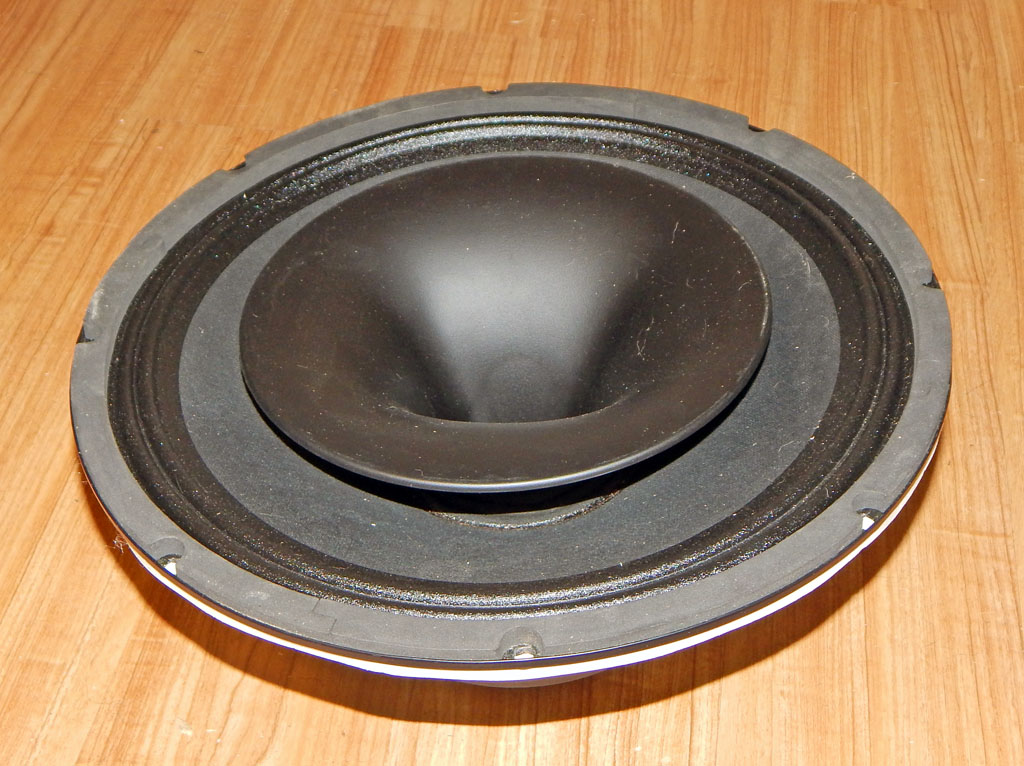
The horn throat transition region is smoothly shaped wider in one axis and narrower in the other axis. Though the horn exit is round, this horn probably has wider dispersion on one axis and narrower dispersion on the other axis. I made a wild guess that the wide axis of the throat transition is also the horn's wide-dispersion axis. Therefore I mounted the speaker with the wide throat transition horizontal in the cabinet and the narrow throat transition vertical in the cabinet. However, some diffraction horns are designed to have the widest dispersion along the narrow axis. Possibly I guessed wrong. Am too lazy to test. Maybe some day will test it.

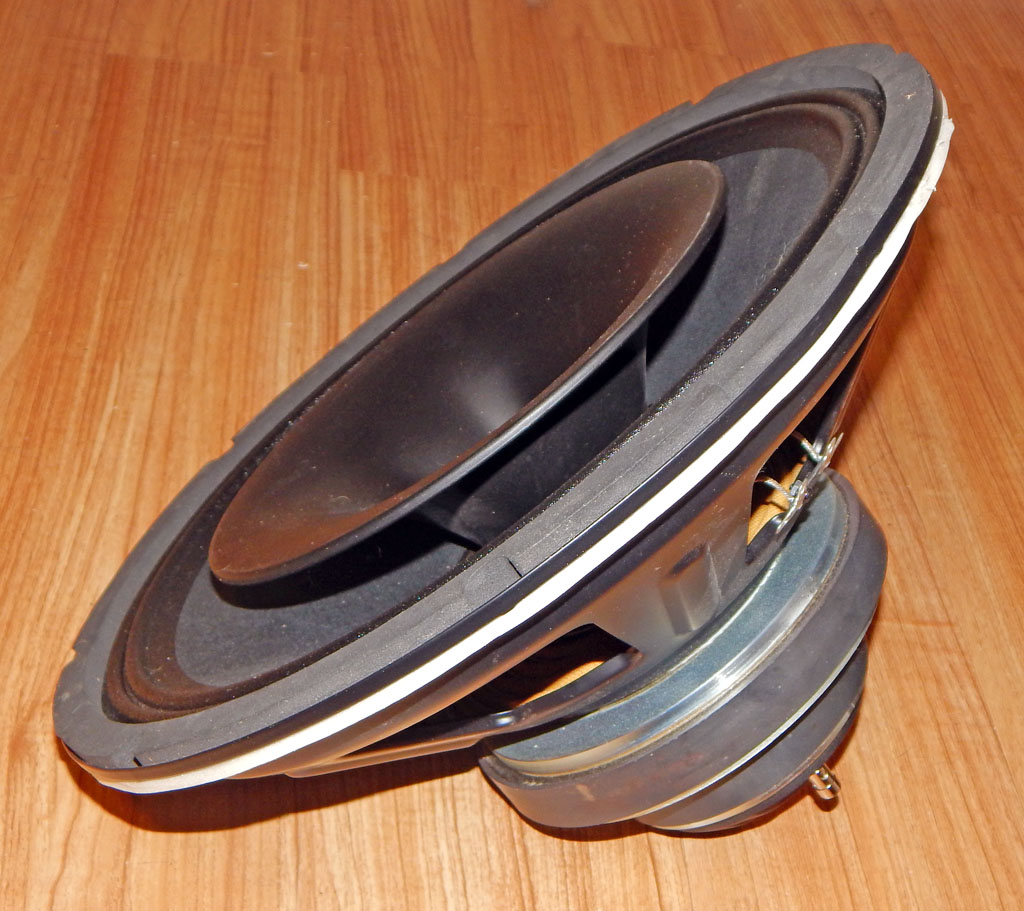
The white rear-mount seal is fairly squishy adhesive foam hardware store weather stripping which I added for better seal against the cabinet. When speaker mounting screws are tightened the foam squashes near-flat.
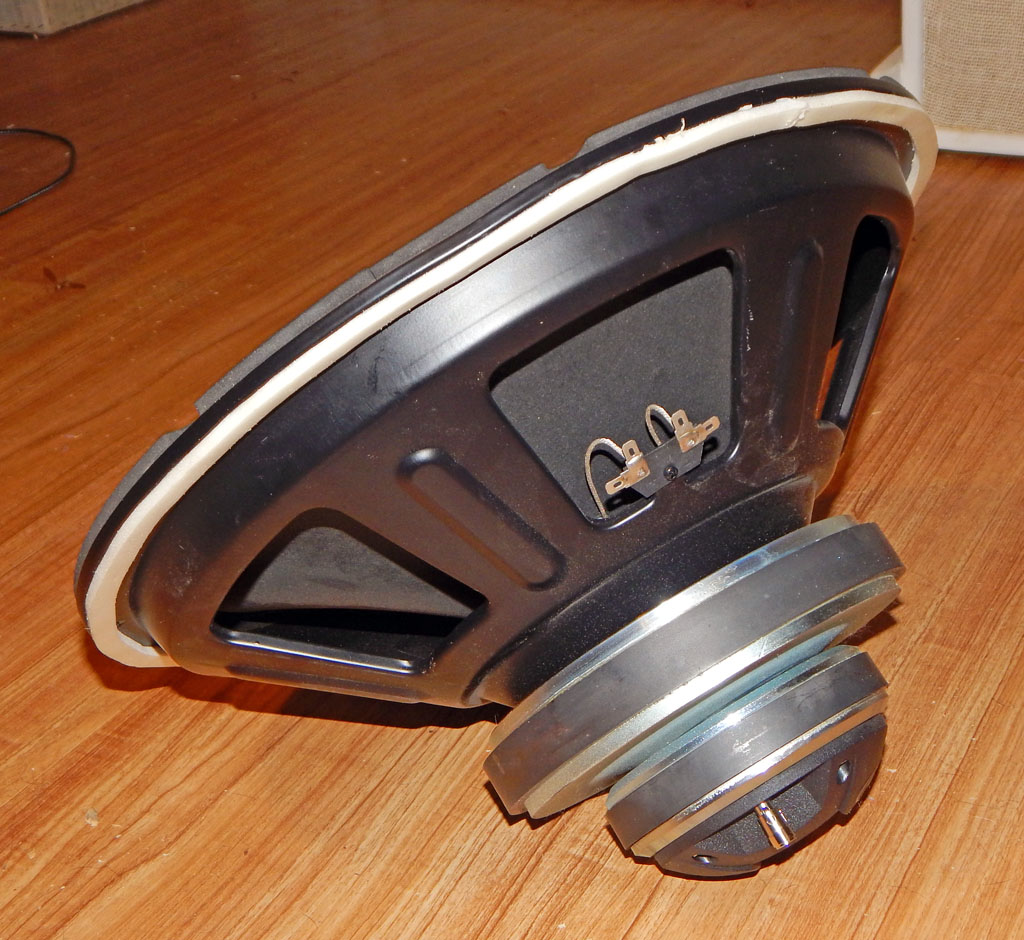

I made the 1200 Hz 24 dB / oct passive Linkwitz-Riley crossover based on a generic schematic generated by one of the online crossover calculator applets. An expert speaker builder would further tweak such a crossover to as-best-possible compensate for specific driver characteristics. However I don't expect ideal behavior-- Only better than the stock keyboard amp. Expecting that a “real crossover” at 1200 Hz ought to have good odds of sounding better than an OEM “almost no crossover at all” at 4600 Hz. Even if the “real 1200 Hz crossover” has not been further tweaked to best-match the specific woofer and horn.
I used 5% tolerance air-wound 18 gauge inductors and 5% 250 volt poly crossover caps. Three inductors were available close to calculated values and the fourth inductor value was close by wiring two stock inductor values in series.
No calculated capacitor values were close to stock values. The cap values were approximated with parallel-wired capacitors. Two parallel caps got “close enough” for three locations and the other location needed three parallel caps.
The crossover is point-to-point wired on quarter-inch hardboard. All components were both wire-tied to the board and also glued down with sticky “50 year guarantee” acetone-based clear weather sealant. The final assembly was heavy enough that I worried that the module might be “too floppy” for possibly rude handling of a road amp. After the wiring I glued plywood strips underneath the fiberboard, covering all board surfaces not obstructed by wires. Finally the underlying plywood strips were glued to another sandwich bottom layer of hardboard. Which resulted in a rigid assembly which was finally attached inside the amp cabinet's 0.75 inch plywood bottom panel via seven 1.25 inch sheetrock screws.
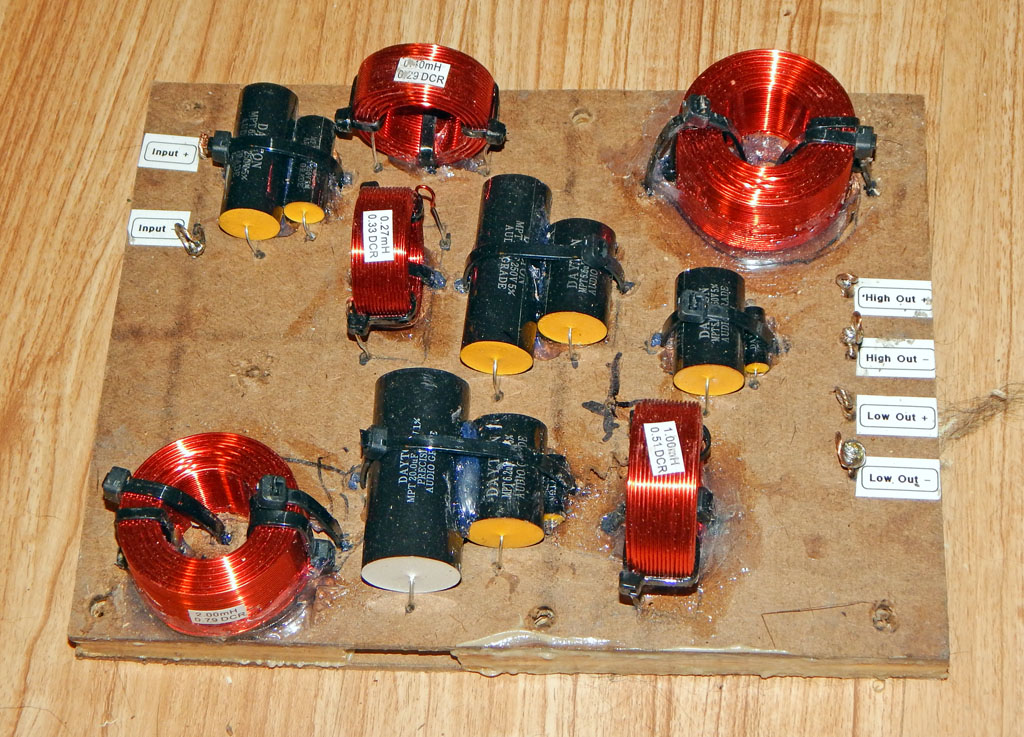
The SA coax speaker assembly is slightly deeper than Roland's OEM 15 inch woofer and the SA coax woofer magnet has bigger diameter than the OEM woofer. The KC-500 cabinet is a sealed design with a generous top-rear cutout to hold the mixer-amp. The “inside shelf” of this cutout prevented mounting the new 15 inch coax speaker. The larger-diameter woofer magnet bumped against the inside edge of the top-rear amplifier cutout.
So I measured an expansion of the amp cutout which shouldn't interfere with the amplifier or its cooling convection, making the cabinet interior big enough to accommodate the bigger replacement speaker. This was a tight woodwork job. Cutting internal detail on an assembled cabinet. I did the first cuts with jigsaw, in spots where the jigsaw would fit inside the cabinet. Then finished the cutout with brutal sloppy sawsall butchery. Crooked cutout lines. I sanded the cut lines somewhat smoother, filled the most egregious gaps with epoxy putty, and then attached the new panels for the cutout hole with lots of PL Premium 3X polyurethane construction adhesive and lots of air nailgun nails. PL Premium dries real hard and tough, expands to fill gaps and is very sticky. Because this cutout won't be visible from normal outside views, I didn't even try to make this modification look pretty. The appearance doesn't matter so long as it doesn't rattle and so long as it is airtight.

The exterior rear panels of the amp cutout and the front speaker baffle were originally painted blue by Roland. I don't like the blue, preferring gloss black. I painted the part of the rear which is visible after the amp is mounted. The blue at the top is Roland's original paint job, which is concealed by the amplifier chassis when reassembled.
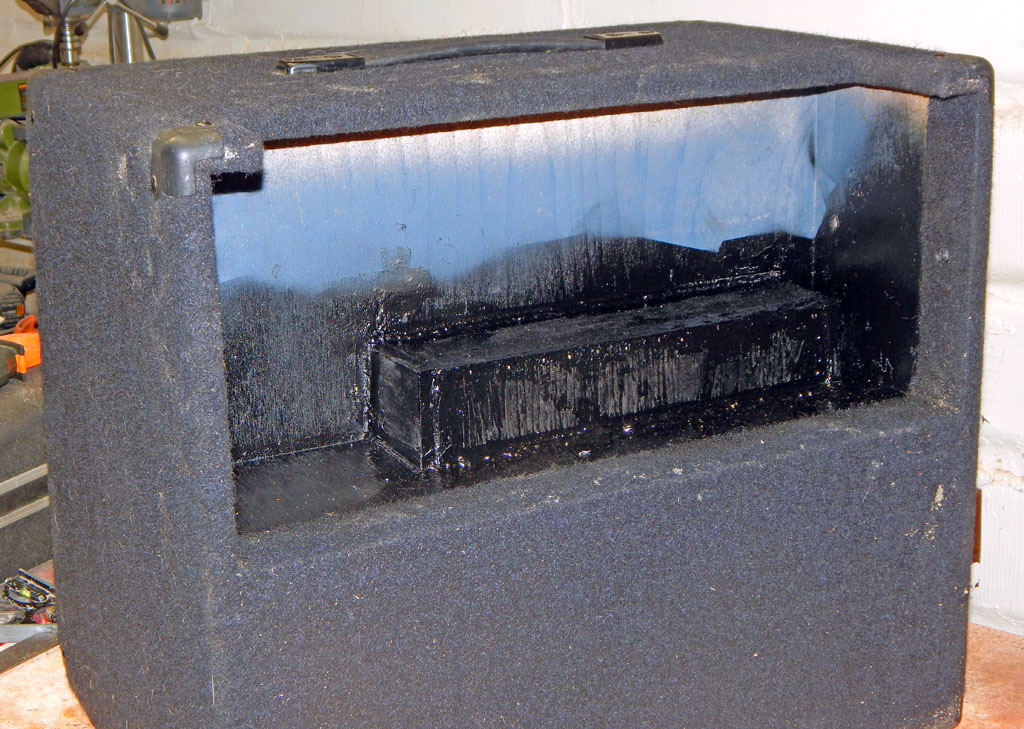
Coax speaker cabinet enlargement inside view--
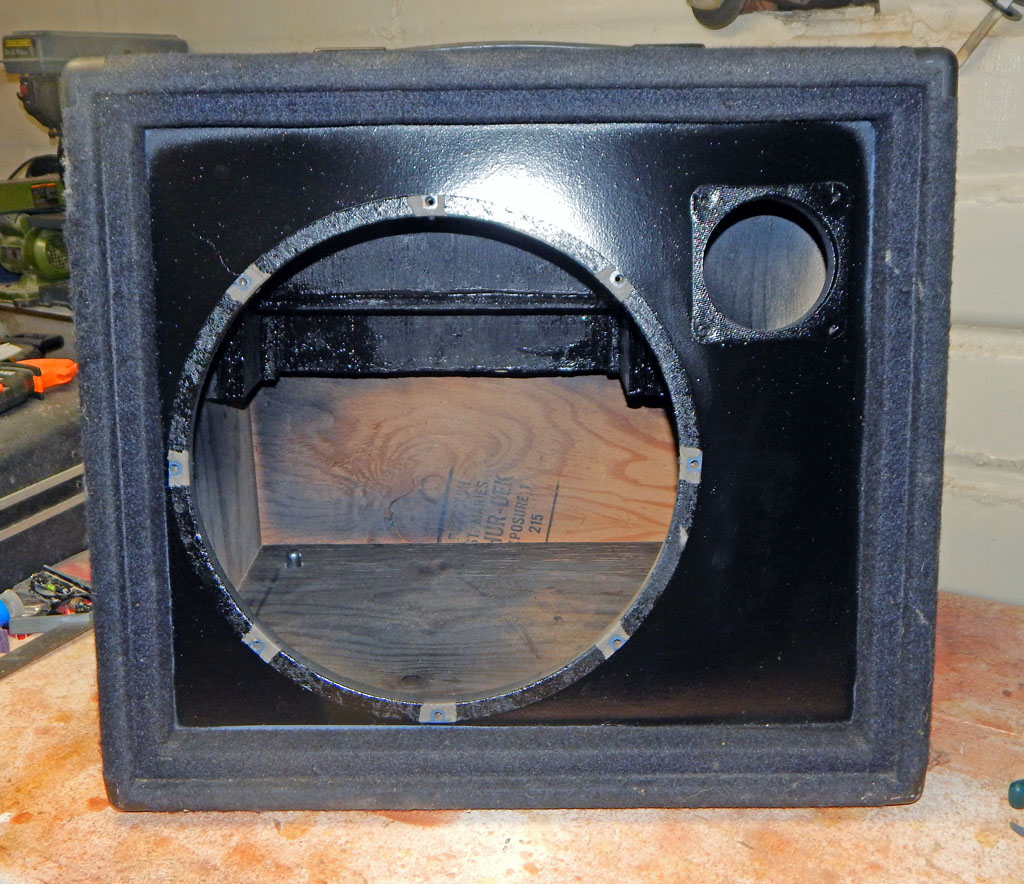
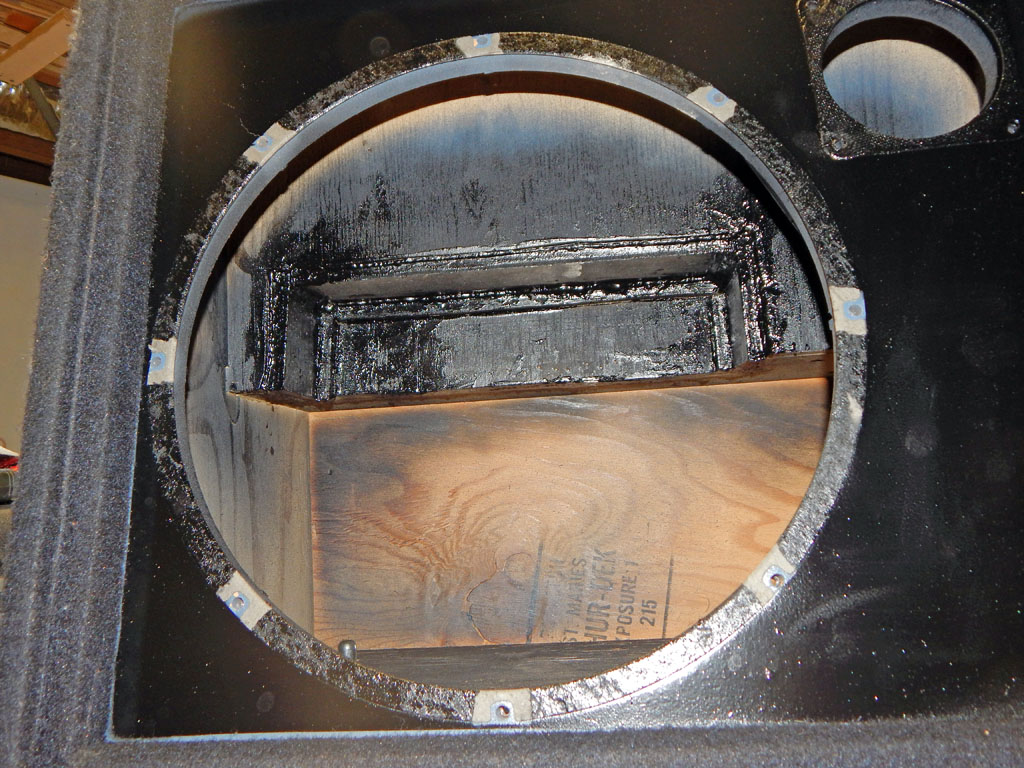
The KC-500 cabinet seems a quite well built sealed design using 0.75 inch plywood. I generally prefer sealed speaker cabs. The OEM cabinet surprisingly contained no internal sound damping. No fiberglass, fiberfill or acoustic foam. Just a bare undamped box inside. Sealed cabs typically sound smoother when stuffed with acoustical damping. Damping changes the impedance and slightly slows the speed of sound inside the cabinet, causing the speaker to behave as if the cabinet is bigger than the physical dimensions.
After installing the crossover and horn L-pad, the cabinet was loosly stuffed with poly fiberfill before finally mounting the new coax speaker.
Horn Damping
There are various internet threads about damping horn resonances with absorptive material. Often it is some kind of expensive unobtanium special foam that you can't buy at a local hardware store. I was curious about horn damping and experimented on my homemade coax studio monitors. So far as I could determine, very light damping really can make a horn less peaky with more pleasant sound.
Having previously experimented on the studio monitor horns, I didn't do extensive A/B testing on the 15 inch coax horn. I just “did the same” as was earlier done to the 12 inch coax horns. Well, after buttoning up the KC-500, I listened to a variety of music for a couple of hours without horn damping, and then listened for awhile after adding the horn damping. So far as my ears can tell, the damped horn has less-peaky more pleasant mids. However I can't swear that this is not a blatant example of placebo effect.
When experimenting with the studio monitor horn damping, I first tried “very low density” polyfill. I took polyfill and pulled it apart into a very light low density and filled the horn throat and horn. Measuring the speaker with damping vs without damping, the horn output was attenuated by about -3 dB from 1000 Hz up to about 5000 Hz and then the rolloff attenuation was progressively greater than -3 dB at higher frequencies.
It was surprising that such a small amount of fluff could attenuate the horn by -3 dB. So I tried to reduce to about -1 dB attenuation and less extra high-frequency rolloff. I pulled out the original handfull of light fluff from each horn, pulled each ball of fluff in half, and then pulled the fibers apart so that half the original amount of fluff would fill the throat and horn. That seemed to give about -1 dB attenuation, less HF rolloff, and so far as I could hear it had audibly smoother mids.
Polyfiber is light and each fiber is springy. You can pull off a tiny wisp of the stuff that will support its own weight forever (or until a breeze blows it away). Attempting similar “very very low density damping” on the 15 inch coax speaker, I just kept pulling off tiny little wisps of a few fibers and dropping them down into the horn until the horn was full to the top. It is difficult to accurately photograph. In the pictures the fiberfill looks denser than it really is. The fluff is so diffuse that the entire damping could be mashed down smaller than the size of a toy marble.
Perhaps horn damping could raise the impedance of a small horn enough to allow a lower safe crossover frequency? Dunno. If you connect a horn driver to a short sealed pipe, or just cram a bottle stopper into the driver exit hole then you could run the driver at rather low frequencies without hurting the diaphragm. Any impedance increase would probably help protect a driver but I haven't any idea how much extra damping would be required to yield a noticeable “driver protection” effect in the real world.
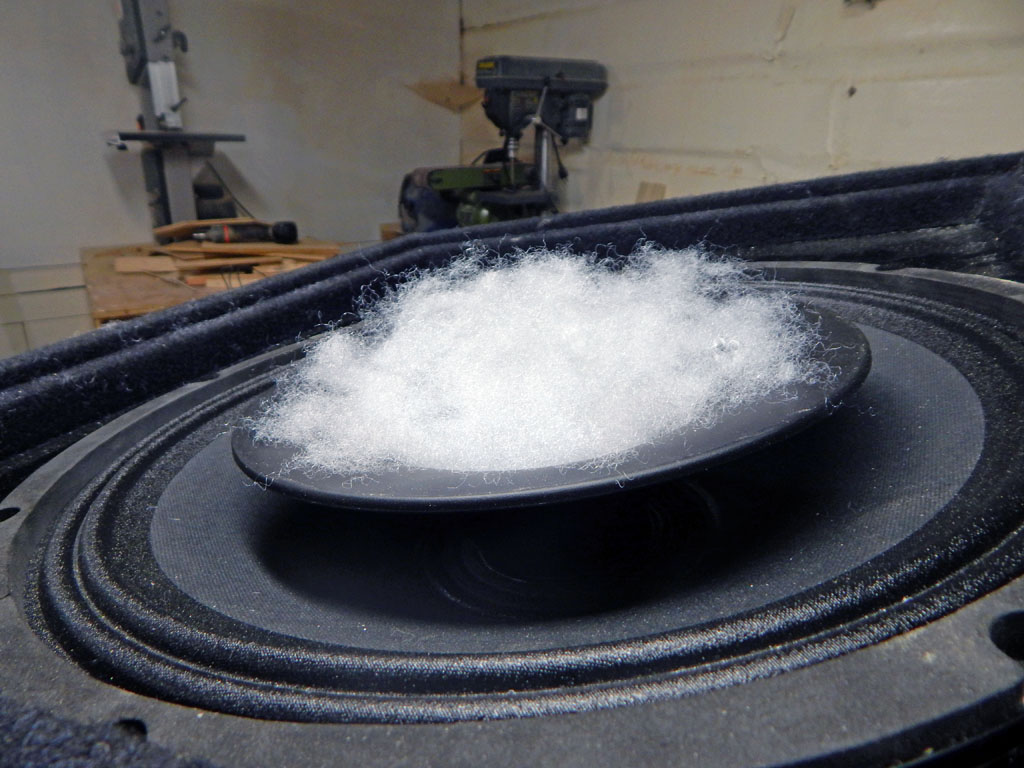

How to make that wisp of fluff stay put in the horn? I used the same solution as with the earlier studio monitors which so far seems long-term durable. The fluffy fiber stays where its put so long as you don't let the fiber fall out of the horn. The diffuse fiberfill isn't heavy enough to settle to the bottom of the horn. I used sheer thin elastic-edged hairnets. This is the only brand I found at walmart. Seems to work great!
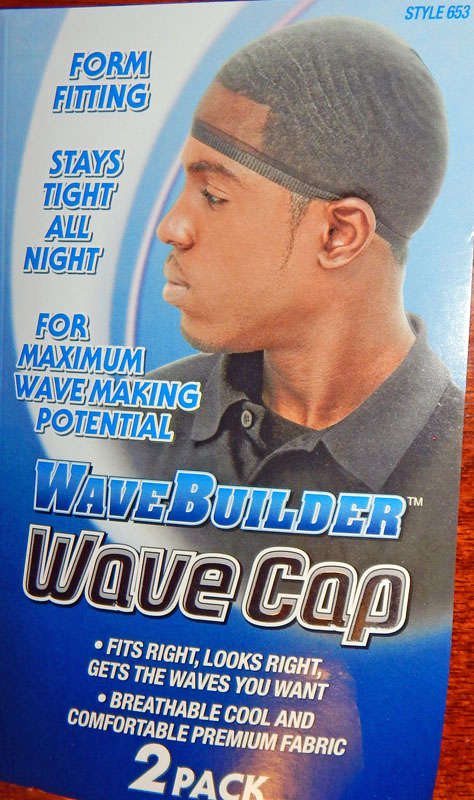
Here it is with the hairnet pulled over the horn, holding the fiberfill damping in-place. When stretched over a horn, the hairnet has a couple of inches loose “nipple” flap of fabric hanging from the middle of the horn. Which probably doesn't matter to the acoustics but I don't like the appearance. The loose center fabric is pulled down and tucked under the elastic behind the bottom of the horn. That is why the fiberfill looks darker right at the bottom-- The fabric is thicker where it is tucked under and the thin black fabric better-hides the white fiberfill behind it.

Finally with the OEM speaker grill re-attached. The steel grill had picked up some rust spots over the years so was touched up with a few coats of gloss black.

As seen in the picture, the cabinet cutout expansion to accommodate the bigger speaker does not crowd the amplifier. I don't see how air ventilation around the power transistor heatsinks would be significantly compromised. The cutout is not deep enough in the front-to-back direction to extend directly under the heatsinks. The air gap depth directly below the heatsinks was unchanged by the cabinet modification.
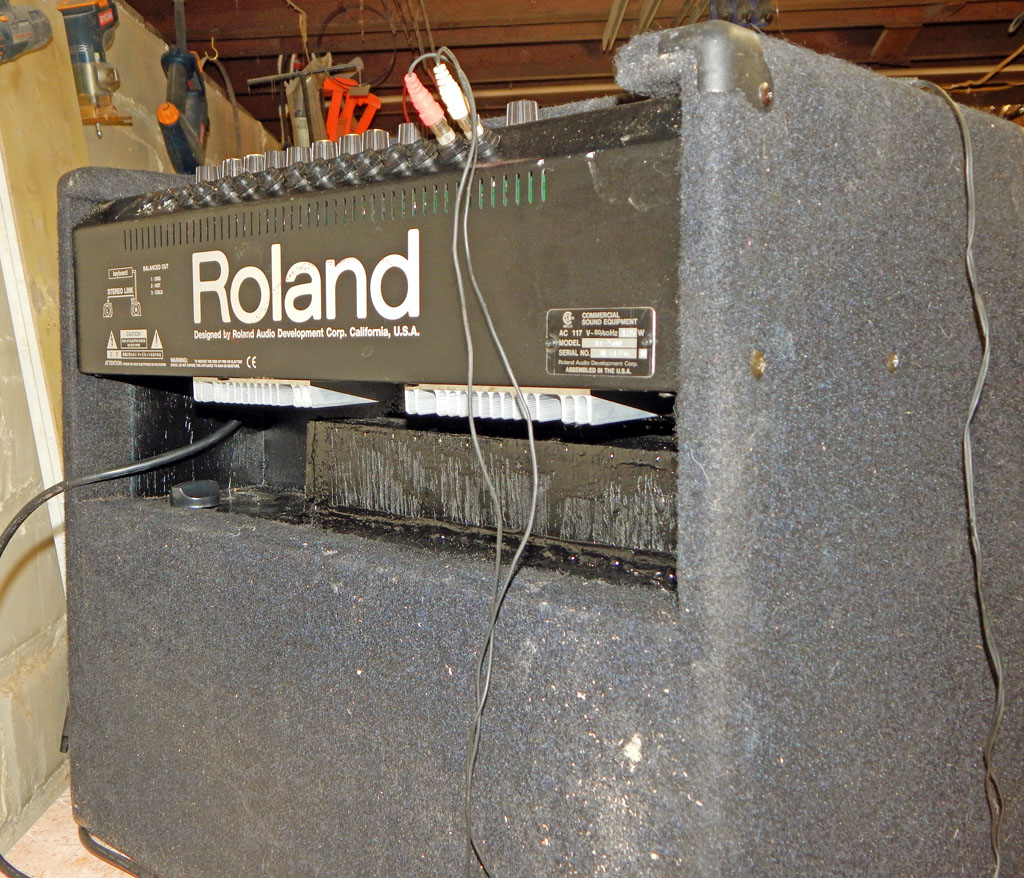
The horn level-adjustment L-Pad is mounted face-up inside the rear amplifier cutout shelf.

Measurement
The best amateur-feasible measurement might be testing the speaker in the yard well away from buildings or trees. I don't have a laptop currently setup with audio interface, mic preamp and measurement software. It would be inconvenient to snake long signal cables out the office window to a speaker in the middle of the yard.
So I performed sleazy testing in my office. Such testing is somewhat informative but any such testing will measure both speaker and room. Unless a room is acoustically treated well enough to approximate an anechoic chamber, any indoor measured speaker response will always be corrupted by the room response.
The office is acoustically treated “pretty good”. The normal way a keyboard amp might be used is tilted back sitting on the floor or possibly tilted back elevated from the floor. This invites floor bounce cancellations but is a typical stage amp usage scenario.
To hopefully minimize floor bounce the KC-500 was measured on its back facing up. An omni measurement mic suspended directly above the coax speaker. Even with ceiling cloud treatment there remain possible ceiling-floor-ceiling bounce aberrations, multi-wall reflections, etc. The only major “not satisfactorily tamed” room mode is a 39 Hz partial null. Treatment reduced the depth of the 39 Hz null but the null was not entirely eliminated.
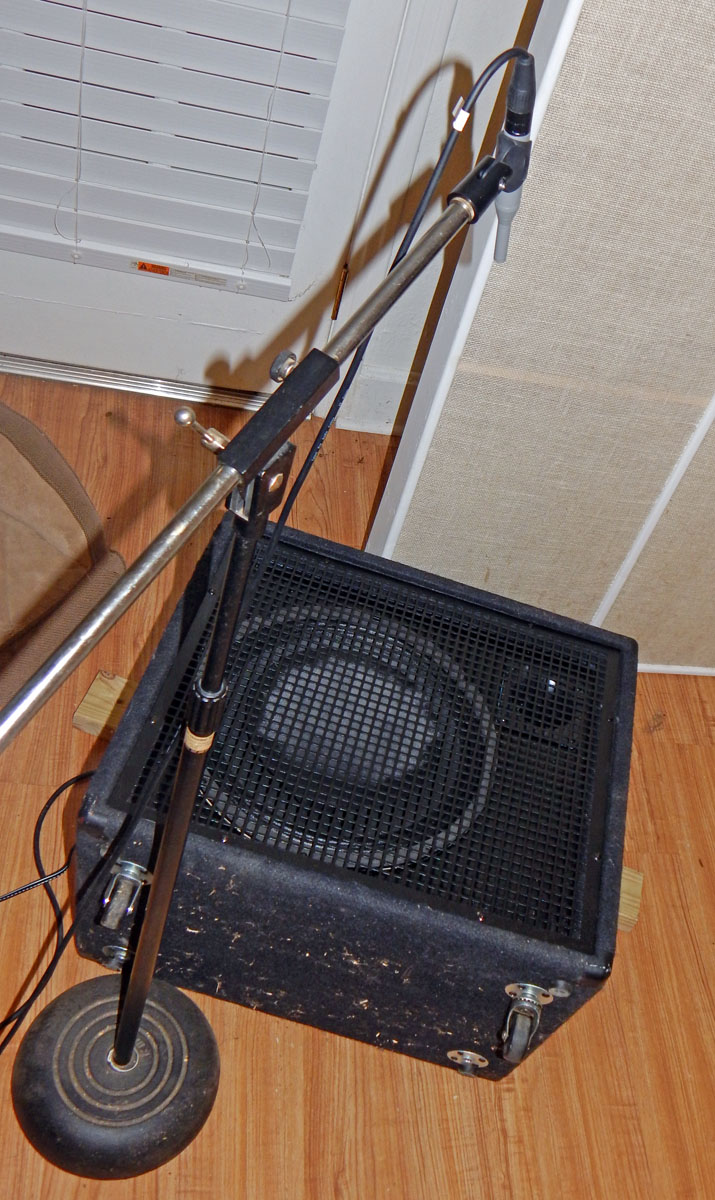
Testing used the Room EQ Wizard RTA mode, 65536 sample FFT locked to 65536 sample periodic pink noise using a rectangular analysis window. This setting is recommended in the REW documentation as one of the better ways to use the RTA feature. It delivers steady “non-twitchy” measurements.
The following three graphs show the same two measurements. The measurement data is identical for each graph but the smoothing differs.
The BLUE MEASUREMENT was accomplished by centering the amp's bass/mid/treble controls and then adjusting the horn L-pad knob for “flattest possible” measurement. I then experimented with various bass/mid/treble knob settings to see if there is a setting which would yield flatter results with only three bands of EQ. About as good as it gets flat compromise was achieved with a slight bass boost, a slight treble boost, and a slight mid cut. Which resulted in the blue lines shown below.
Then I positioned the speaker to the usual “sitting on the floor slightly tilted back” position and ran the computer audio player with random playlist, evaluating the sound by ear. The blue line response sounded too bright to the ear on commercial mixes in my treated room. So I left the tone controls adjusted with the same “slight bass and treble boost, slight mid cut” and turned-down the horn L-Pad knob until commercial songs sounded about as good as it was gonna get. Then I flipped the amp on its back again, positioned the mic above the amp and took the GREEN MEASUREMENT. Finally, to better-facilitate visual comparison, the two measurements were vertically offset to intersect each other around 1 kHz.
The charts are zoomed-in at 1 dB per division to better emphasize the warts. Based on the first chart's octave-smoothed blue “flat as possible” measurement, specing “overly optimistic” as practiced by some speaker manufacturers-- We might claim that this modified KC-500 is flat from 44 Hz to 10 kHz within +/- 3 dB. Or if we use even-more-optimistic but commonly used -10 dB thresholds, we might claim that this amp is flat from 33 Hz to 14 kHz! I'm just joking because such practices are basically bullshit numerology.
Also, remember that the treated room response is mangled together with the speaker response. I don't know which smoothing resolutions give useful information about the speaker, even if clouded by room response. My studio monitors in that treated room are better positioned and carefully tweaked. On the studio monitors most of the frequency response is less than +/- 2 dB at 24th octave smoothing. The studio monitors + room measure near ruler flat with Octave smoothing.
So PERHAPS the octave-smoothed data gives us the most reliable (if sparse) information about the modified amp, because the room alone ought to measure near-flat at octave smoothing. So maybe the octave smoothed squiggles are mostly real contributions by the speaker response.
Maybe the more-detailed charts provide useful information or maybe not. Some peaks and dips are speaker and some peaks and dips are room.
Chart features I am inclined to “believe”
Am fairly certain that the bass bump at about 87 Hz is a real characteristic of the amp. Also fairly certain of the rolloff below about 60 Hz. A few years ago when I was treating my office and experimenting with speakers and subwoofers, I wondered if the KC-500 might make a decent subwoofer along with the JBL mains. I put the KC-500 in the office front subwoofer location and hooked it up to the DriveRack's subwoofer crossover output. The KC-500 performed like gangbusters down to about 60 Hz but rolled off so severely below 60 Hz that it required massive EQ to get it flat down to 40 Hz while also avoiding way-too-loud above 65 Hz. The cab may have slightly more bass with the SA coax speaker, but I can hear playing keybass on it the same steep rolloff below about 60 Hz. Though this is truly hard to judge because of nulls in my temporary untreated practice room. The room nulls may be fooling my ear and maybe it is doing better below 60 Hz than my ear can judge in the untreated practice room.
I had been hoping that a different woofer, or adding some stuffing to the sealed cabinet might somewhat improve the low bass response. On the other hand the cabinet is on the small side to hold a 15” speaker and that might be about the best to expect from such a small cabinet, except maybe by driving lots of power thru a steep EQ.
Or it might be possible that Roland chose some component values in the Amplifier circuit to intentionally rolloff below about 60 Hz, hoping to better-protect the woofer or power amp from burning up when played louder than dammit? If the Amplifier electronics are rolled-off then that would explain such a sudden steep bass rolloff. The rolloff seems rather steep considering typical sealed cabinet characteristics. Usually sealed cab rolloff would not be quite so sudden. Maybe one day I will study the amp schematic searching for any suspiciously-small-value coupling capacitors.
Actually I discovered only a few years ago that MANY bass guitar amplifiers do not go flat to 40 Hz. For decades I had just assumed that surely a typical bass amp is designed to play flat down to 40 Hz. The search for info is made difficult because not many manufacturers list frequency response specs of bass guitar amps and bass guitar speaker cabs. But it is perhaps common that typical bass amps start rolling off around 60 Hz or higher, and you have to EQ kick them pretty hard to play flat down to 40 Hz. So maybe the KC-500 low bass rolloff is “more rule than exception” among “small” keyboard and even “small” bass amps? Dunno.
I do not know if the response dip around 300 Hz is real or is it a room measurement artifact?
I suspect that the response dip around 1200 Hz is probably real. It was such a surprise to see a dip at almost exactly the crossover frequency that I got paranoid maybe I'd wired the horn and woofer out of phase. So I took it apart and measured with the horn connected both ways. My original wiring was correct, because the 1200 Hz null measured dramatically wider/deeper when wired the wrong way.
I suspect that the high frequency rolloff starting at about 3 kHz and getting steeper around 9 kHz is probably real, because the 12” coax horns in the homemade studio monitors do the same unless I boost the high EQ a little bit to flatten it out.
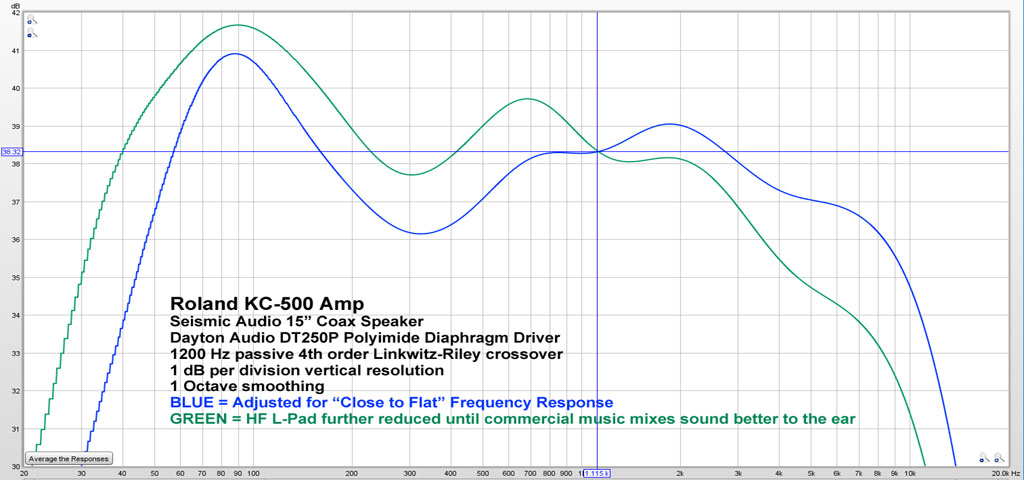

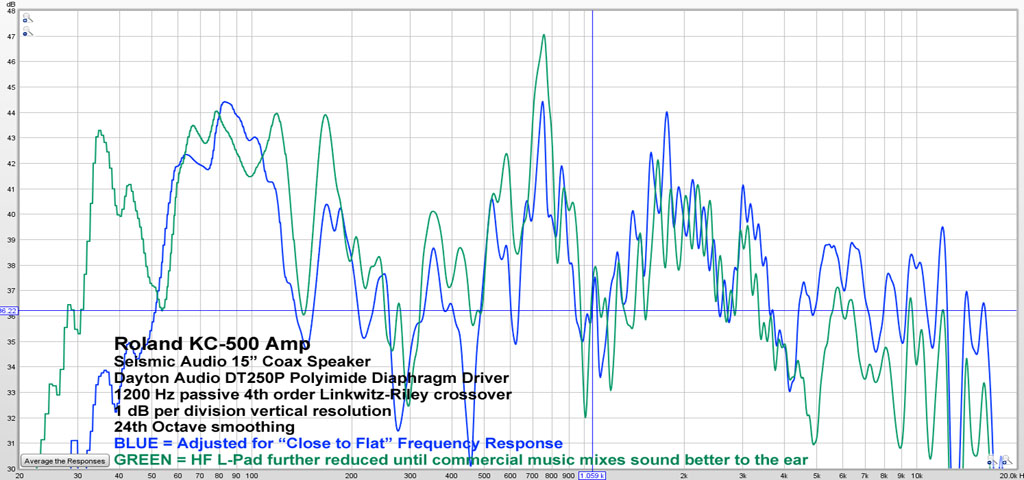
It is hard to evaluate a stage speaker because most rooms' acoustics are not very good. Even with bad acoustics at a gig, it seems somehow possible to judge whether a speaker system is good or bad. After a couple of days playing keyboards thru the modified KC-500, it seems to sound sweeter. If I later change my mind I will revisit and edit this page.
There isn't room in the small treated office to setup my “gig rig” I'm building, so keyboard-playing ear evaluations are also in sucky acoustics. The temp practice room with the gig keyboards and the KC-500 measures 12 X 12 X 6.5 feet. Square dimensions are nearly the worst possible acoustics, giving a double dose of modal peaks and nulls. At the very least strong peaks can be expected at 94 Hz (walls) and 173 Hz (floor-ceiling). With strong nulls expected at least at 47 Hz (walls) and 87 Hz (floor-ceiling). Most likely two harmonically-related series of peaks and nulls based on 47 and 87 Hz. This could equally mask both any good or bad points a speaker might have.
Should have bought a few more crossover parts
When planning the KC-500 upgrade I figured that the Fostex tweeter would likely interfere with the coax horn and so I had planned to leave the Fostex tweeter installed (to keep the cabinet sealed) but disconnect the Fostex tweeter.
However that tweeter is “pretty good” in its ideal frequency range, so after I had ordered all the crossover parts, when I was installing the new crossover, I began to wonder if maybe the speaker would sound better as a threeway, woofer, coax horn and Fostex super-tweeter. Horn drivers which are good at midrange generally start rolling off around 10 kHz or whatever, though they can be somewhat treble-boosted without sounding gruesomely ugly. Boost the highs too much on a driver appropriate for mids and you can expect HF breakup. Equivalent to the breakup you get by pushing too many highs thru a big woofer.
Maybe the Fostex tweeter would sound excellent in a threeway along with the 15” coax speaker, if I had bought extra caps and coils to make a 12 or 18 dB/oct 5 kHz crossover between the Fostex and the coax horn.
Just to see if it would work with the stock Roland first-order 4600 Hz highpass, I first wired it up running the coax woofer and horn off the 24 dB/oct new crossover and then running the Fostex horn thru the original simple Roland highpass. The Fostex simple highpass slope was too gradual, leading to frequency oddities around 5 to 8 kHz where the coax horn and Fostex horn were fighting each other, and there were even a few extra frequency oddities down around 1200 Hz, where the Fostex first-order highpass remained loud enough to fight against both the coax horn AND the coax woofer!
So I went back to the original plan, leaving the Fostex tweeter in-place but disconnected from the amp. Next time I order enough parts to qualify for free shipping, maybe I'll try the Fostex tweeter again along with a decent crossover between the Fostex tweeter and the coax horn. Maybe it could sound pretty good with a proper crossover? Or maybe the horn and tweeter would fight each other too much even with a proper crossover? Can't even guess without a fair test.